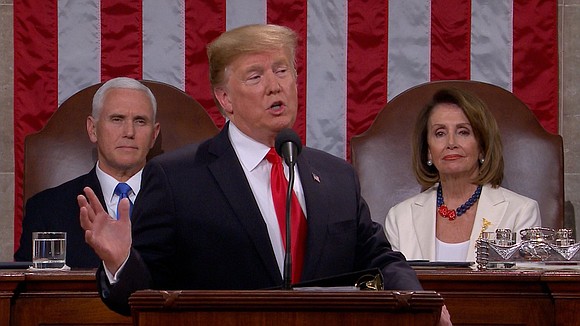Trump 'not happy' with deal, weighing options for building wall
CNN/Stylemagazine.com Newswire | 2/12/2019, 11:47 a.m.
By Kevin Liptak, Dana Bash and Kaitlan Collins, CNN
(CNN) -- President Donald Trump voiced displeasure Tuesday at a border security deal struck by congressional negotiators, hinting it may not meet his requirements for constructing a wall.
"Am I happy? The answer is no, I'm not. I'm not happy," Trump said when questioned about the agreement during a meeting of his Cabinet at the White House. He said he was still studying the details of the agreement.
But he stopped short of saying he would reject the accord, which Democrats and Republicans announced late Monday. Instead, he suggested he had other mechanisms ready to deploy to satisfy his need for border wall funding.
"I'm adding things to it," Trump said.
The President must soon decide whether he can accept the border security deal struck by congressional negotiators that falls far short of his original demands.
The agreement, which includes $1.375 billion for a border barrier, falls well short of the $5.7 billion he originally demanded for a wall. It even falls short of the $1.6 billion included in a Senate package last year.
Still, the measure would avert another government shutdown, which polls showed Trump took the blame for last time around.
The White House says Trump is continuing to weigh his options -- which still include taking executive action to secure funding for a wall.
"We're not going to get into a conversation of what could be in this document. We want to focus on what's actually in the document. Until we see that it's going to be very difficult to have a conversation about what we will and won't accept," spokesman Hogan Gidley told reporters at the White House on Tuesday.
White House officials have a roster of options they have been weighing that would employ the President's executive authority to secure money for a border wall. Not all would require declaring a national emergency. The President is being urged by conservatives to take executive action in conjunction with signing the compromise legislation that would avert a government shutdown.
It's not clear which combination of actions the President might use, and the topic has been under debate for weeks. The estimates for how much each option could garner have also been under debate. The President has held nearly daily meetings with senior advisers and others to discuss his options.
Drafts of the executive orders or declarations have been circulating for weeks inside the West Wing. All have been heavily examined by the counsel's office and the Justice Department, and most White House aides believe any executive action will prompt legal challenges.
The various options have come with differing legal outlooks, according to people familiar with the matter. There are also concerns about landowners bringing legal challenges should their land be seized for border construction using eminent domain.
Moving money from disaster relief funds is also seen as politically problematic by some senior aides.
The White House is prepared to roll out executive actions piece by piece, not necessarily all at once, once the President signs off.
In reality, it won't be as easy as just signing one piece of paper and being done with it. That's what acting chief of staff Mick Mulvaney and other agency heads have been up to over the past weeks: finding pools of money they can use to fund a border wall. Some of those will be easy and some will be more difficult legally, aides familiar with the matter said.
Even as lawmakers haggled over details of their agreement, the White House had been planning behind the scenes to secure the funds unilaterally. That is partly why administration aides weren't phased over the weekend when reports emerged the talks had broken down.
The President's unilateral options include:
Accessing Treasury forfeiture funds
An estimated $680 million
-Would not require the President to declare a national emergency.
-Includes unobligated funds from participating agencies that can be used to support law enforcement activities.
-After the Office of Management and Budget reviews the order, Treasury and the Department of Homeland Security would both notify Congress then wait 15 days before the funds can be obligated.
-Acquisition of land is allowed under this option.
Using USC 284 to divert some Pentagon funds for counter-narcotics
An estimated $700 million
-May not require the President to declare a national emergency, according to a CRS legal report.
-DHS must exercise a waiver to transfer counter-drug funds to construct fencing to block drug smuggling.
-DHS asks Department of Defense to assist after identifying a location where a fence is needed to block drug smuggling corridor.
Using USC 2808 to gain access to military construction funds
An estimated $3.6 billion
-Would require the President to declare a national emergency.
-Would require the use of the military.
-The President would declare border protection a Defense Department mission.
Use Army Corps civil works funds using USC 2293
An estimated $3 billion
-May require the President to declare a national emergency, but could also be used without a national emergency, according to a CRS legal report.
-The Secretary of the Army may stop or defer Army civil works projects and apply funds to help build civil defense projects essential for the national defense (Secretary of the Army makes the final -determination if essential to national defense)
-The unspent funds that could be used are now designated to go toward Army Corps of Engineers projects to repair infrastructure damaged by natural disasters.









